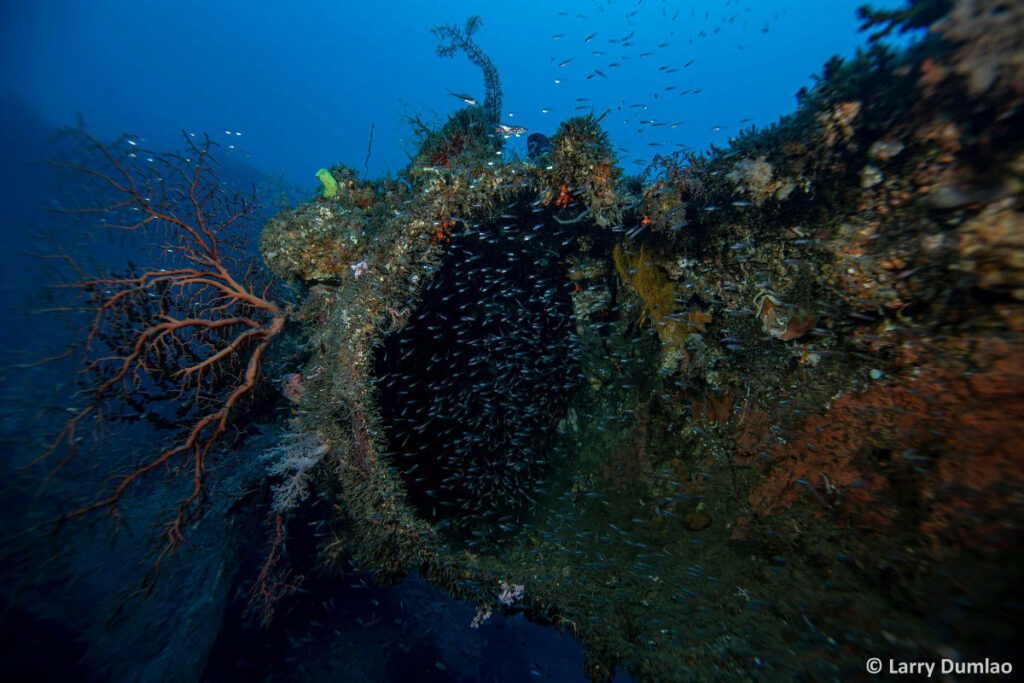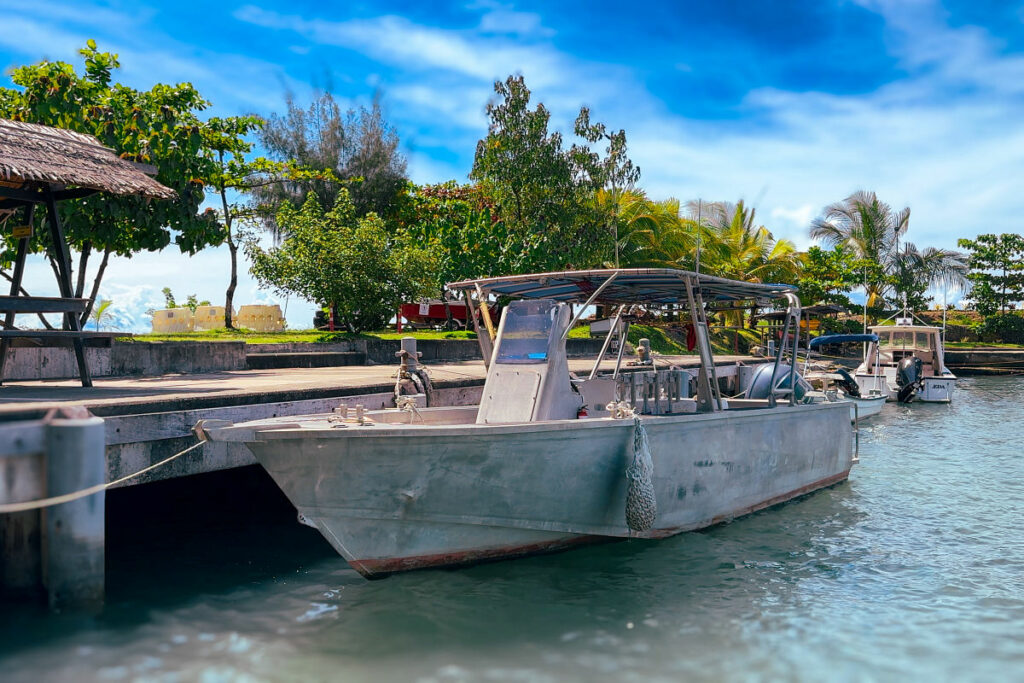Honiara - Day Diving & Dive Sites
Day diving at Emperor Honiara is your gateway to a myriad of unforgettable experiences.
Within minutes of leaving of our centre, you can be exploring amazing reefs or incredible wrecks while surrounded by some of the most diverse marine life in the world. This is the best way to see the abundant remains from the infamous Battle of Guadalcanal – one of the most intense conflicts of World War II.
Part of the area is known as Iron Bottom Sound because of the volume of wrecks that found their final resting place beneath these waters and we offer the chance to see these incredible sights without spending time on a liveaboard.
Find out more about the Battle of Guadalcanal and Iron Bottom Sound
With a full range of courses – from try dives to Trimix – and top-quality equipment for rental, our team will look after all your needs and requirements while guiding you to famous spots such as the Japanese Mavis Seaplanes, USS Aaron Ward and the B-17 Flying Fortress.
You really couldn’t be in better hands. We have been diving in the Solomon Islands since 1988 when our liveaboard partner Emperor Bilikiki first began showing guests the amazing sights this incredible country has to offer. We know these waters so well and can’t wait to share them with you.
To book your package or ask any questions, contact our team via email on [email protected] or by WhatsApp on +677 7155694.


Emperor Divers Honiara is the premier diving centre in the city and we give divers – new and experienced – unrivalled access to explore these waters and the delights held within them.
- Amazing World War II history just minutes away
- Standard shore diving includes two shore dives per day with guide, tanks, 11L air/nitrox tanks, and weights.
- We have the only instructor of technical diving based in the country, meaning guests will be able to develop their skills even further.
- A full range of courses available from Discover Scuba Diving to advanced tech skills.
- If you haven’t dived for a while, we recommend you take a scuba review as required by your training organisation.
Day Trips
We often do a combination of two sites in one day, so morning and afternoon are in different places. Listed below are some of the dive sites included in a dive package price and visited on a rotational basis.
- Hirokawa Maru: Also known as Bonegi 1, it was a 6,860-ton Japanese vessel that beached during the Battle of Guadalcanal and subsequently sank after being subjected to heavy bombing by the US Air Force. The wreck has become a reef hosting diverse corals, fish, and other marine organisms.
- Kyushu Maru: A Japanese transport ship that lies in Iron Bottom Sound, a stretch of water named for the numerous ships and aircraft sunk there. The wreck is encrusted with corals and sponges, attracting a diverse array of marine life, including schools of snappers, fusiliers, trevally, lionfish, nudibranchs, and anemonefish.
- Twin Tunnels: This large seamount features two tunnels that drop vertically and exit into a cave. Swimming out of the cave to the sheer wall, you’ll encounter schools of fusiliers and grey reef sharks cruising by.
- Tanavula Point: A gently sloping reef offering encounters with pelagics like eagle rays, dogtooth tuna, and occasional sharks, making it suitable for both novice and advanced divers.
- Maravagi Bay: A macro divers delight! A calm protected bay offering all sorts of great macro subjects.
- USS Aaron Ward: A technical dive, the Aaron Ward has become an artificial reef, attracting diverse marine life and offering a poignant glimpse into naval history. Divers can observe the ship’s armaments, including its 5-inch guns still pointing skyward, and other features that testify to its final battle.
Azumasan Maru: Another tech dive, a freighter requisitioned by the Imperial Japanese Navy during World War II, it was deliberately beached but still sank into Iron Bottom Sound. The wreck now lies upright on the seabed, with the bow at approximately 39m and the stern descending to nearly 90m.
Honiara Dive Sites
Click dive site markers for detailed descriptions. Some dive sites may only be visible on zooming out.
Dive sites & areas that we may visit are subject to weather conditions and may involve additional charges.
Devil's Highway
The best place in the Solomons to dive with manta rays. A channel between two islands funnels water to form a strong currents and an adrenaline filled dive. Drift along the reef top, duck under the reef wall and watch as up to a dozen mantas swim close by in formation to feed. They are often joined by sweetlips, jacks and bumphead parrotfish.
Japanese Mavis Seaplane
A Japanese seaplane sunk during WW2 which sitson the bottom atit is an impressively large, mostly intact plane. This site is also excellent for macro subjects with reef top pipefish, twin spot gobies and spine check anemone fish.
Maravagi Bay
A macro diver’s delight! A calm protected bay offering all sorts of great macro subjects such as nudis, demon stinger, scorpion fish, cockatoo wasp fish, various pipefish, cuttlefish, juvenile batfish, various anemone fish, shrimps and crabs. Plus a few of giant clams and a small wreck packed with batfish and bream.
Twin Tunnels
This large seamount, located in the middle of the channel between Guadalcanal and the Florida Islands, features two tunnels that drop vertically and exit into a cave. Swimming out of the cave to the sheer wall, you’ll encounter schools of fusiliers and grey reef sharks cruising by. The area is also home to stunning coral, cuttlefish, octopus, and shrimp, as well as schools of snapper, tropical fish, and an incredible variety of anemonefish.
Velvia
Velvia is a vibrant dive site located near Mangalonga Island in the Florida Islands of the Solomon Islands, known for its colorful coral gardens and excellent macro life. Divers often encounter rare species such as Nembrotha kubaryana, a striking nudibranch that is uncommon elsewhere in the region. The site offers calm conditions and clear waters, making it ideal for underwater photography and relaxed exploration.
Tanavula Point
A steeply sloping reef offering encounters with pelagics like eagle rays, dogtooth tuna, and occasional sharks, making it suitable for both novice and advanced divers.
MS World Discoverer
Home to the partially submerged MS World Discoverer cruise ship, which struck an uncharted reef in 2000. The MS World Discoverer has become an artificial reef over the past two decades, attracting a diverse array of marine life. Divers and snorkelers can explore the coral-encrusted hull, observe schools of fish, and encounter various invertebrates that have made the wreck their home. The site offers a combination of historical intrigue and vibrant underwater ecosystems, suitable for divers of various experience levels.
Simon's Nature Reserve
Simon's Nature Reserve is a vibrant coral sanctuary located along the western shoreline of Sandfly Passage in the Florida Islands of the Solomon Islands. Established by Simon, a dedicated local conservationist, this protected area boasts over 80 genera of coral and serves as a haven for juvenile fish. The reserve is situated approximately an hour's boat ride northwest of Tulagi, near the village of Baroni on Nggela Sule Island.
Catalina Floatplane Wreck
The PBY-5A Catalina wreck near Tulagi in the Solomon Islands is a notable World War II dive site. This American flying boat rests upright on the seafloor at a depth of approximately 33 meters (108 feet). The aircraft is largely intact, with its wings attached and resting on their floats. Notably, the left engine has detached from its mount and is propped up in the sand on two of its three propellers. Machine gun bullets are still visible along the rear fuselage, offering a poignant glimpse into its wartime history.
F4F Wildcat Wreck
This Grumman F4F-4 Wildcat fighter aircraft rests upright on a sandy seabed at a depth of approximately 42 meters. Discovered in 2015 just offshore from the Raiders Hotel amp; Dive, the wreck is largely intact, with the exception of its missing propeller and detached engine cowling.
Hirokawa Maru
The Hirokawa Maru, also known as Bonegi 1, was a 6,860-ton Japanese cargo vessel repurposed as an armed transport. On 15 November 1942, during the Naval Battle of Guadalcanal, it was beached near Bonegi while attempting to deliver troops and supplies. Subsequent attacks by U.S. forces led to its sinking. Over the decades, the wreck has become an artificial reef, hosting a diverse array of corals, fish, and other marine organisms.
Kinugawa Maru
The Kinugawa Maru, also known as Bonegi 2, was a Japanese transport ship that ran aground on 15 November 1942 during the Naval Battle of Guadalcanal. Later that day, U.S. forces attacked the ship, leaving it burning. Today, parts of the wreck remain above sea level, while the rest lies submerged, accessible to divers. Over the decades, the wreck has become an artificial reef, hosting a diverse array of corals, fish, and other marine organisms.
Kyushu Maru
The Kyushu Maru, also known locally as Bonegi 3, is a Japanese transport ship which was sunk on 15 October 1942 during the Guadalcanal Campaign. The wreck lies in Iron Bottom Sound, a stretch of water between Guadalcanal, Savo Island, and Florida Island, named for the numerous ships and aircraft sunk there during the campaign. The wreck is encrusted with corals and sponges, attracting a diverse array of marine life, including schools of snappers, fusiliers, trevally, lionfish, nudibranchs, and anemonefish.
B-17 Flying Fortress Wreck
This aircraft, nicknamed “Bessie, the Jap Basher”, was a B-17E model with serial number 41-2420. It ditched into the sea on 24 September 1942 after sustaining damage during a bombing raid on Japanese shipping near Bougainville. The B-17's wings, fuselage, and cockpit remain largely intact, although the tail section was removed in 1944 by U.S. Navy Seabees. The wreck lies on a sandy seabed and has become an artificial reef, attracting various marine life. The aircraft's resting place serves as a poignant reminder of the intense air battles fought over the Solomon Islands during World War II.
I-1 Submarine Wreck
The I-1 Japanese submarine cruiser was sunk on 29 January 1943 during a confrontation with the Royal New Zealand Navy's minesweepers, HMNZS Kiwi and HMNZS Moa, near Kamimbo Bay. After sustaining damage from depth charges and gunfire, the I-1 was forced to run aground on a reef, where it ultimately sank. The wreck is partially intact. In 1972, an attempt to salvage valuable metals resulted in an explosion that destroyed the forward third of the submarine. The remaining structure has become an artificial reef, hosting diverse marine life.
Solsea
This site features the remains of an island trader vessel that was intentionally scuttled onto a reef. The ship now rests upright on an incline, with its bow pointing skyward, creating a striking underwater silhouette.
The wreck has become a thriving artificial reef, attracting a diverse array of marine life. Divers can expect to encounter schools of Spanish mackerel and rainbow runners near the surface, while deeper sections of the wreck are frequented by coral trout and red emperor. The site offers depths ranging from 18 to 40 meters, making it suitable for advanced divers seeking both historical intrigue and rich biodiversity.
USS Serpens
The USS Serpens (AK-97) was a U.S. Navy cargo ship manned by the Coast Guard during World War II. On 29 January 1945, while anchored off Lunga Beach on Guadalcanal in the Solomon Islands, the vessel suffered a catastrophic explosion during the loading of depth charges. This tragic incident resulted in the deaths of 196 Coast Guard crewmen, 57 Army stevedores, and a Public Health Service physician, marking it as the largest single disaster in U.S. Coast Guard history.
The cause of the explosion was never definitively determined. Initially attributed to enemy action, a subsequent court of inquiry concluded that the explosion was likely due to an accident intrinsic to the loading process.
The wreck of the USS Serpens lies in Ironbottom Sound, a body of water named for the numerous ships and aircraft lost during the Guadalcanal Campaign.
As a war grave, the USS Serpens wreck is a solemn site, and diving activities are subject to restrictions to honor the memory of those who perished.
USS John Penn
The USS John Penn (APA-23) was a U.S. Navy attack transport ship that met its fate during World War II. On 13 August 1943, while anchored off Lunga Point near Honiara, Guadalcanal, the vessel was struck by a Japanese aerial torpedo, leading to its sinking. The wreck now rests in Ironbottom Sound, a body of water named for the numerous ships and aircraft lost during the Guadalcanal Campaign.
The USS John Penn has become an artificial reef, attracting a diverse array of marine life. Divers exploring the site can expect to encounter schools of fish and vibrant coral growths that have colonized the wreck over the decades. The combination of historical significance and marine biodiversity makes it a compelling dive for those with the requisite experience.
Please note that the wreck is considered a war grave, and divers are expected to treat the site with respect.
Azumasan Maru
The Azumasan Maru was a Japanese freighter built in 1933 and later requisitioned by the Imperial Japanese Navy during World War II. In October 1942, while attempting to resupply Japanese forces on Guadalcanal, the ship was attacked by U.S. aircraft. After sustaining significant damage, it was beached near Bunani Point to prevent sinking. However, further bombing on October 16 caused it to slip off the reef and sink into Ironbottom Sound. The wreck now lies upright on the seabed, with the bow at approximately 39 meters and the stern descending to nearly 90 meters.
Sasako Maru
On 15 October 1942 the Sasako Maru was attacked by U.S. aircraft while unloading troops and supplies near Bunani Point. After sustaining damage, it was deliberately beached, but subsequent bombing caused it to slip off the reef and sink into Ironbottom Sound. The Sasako Maru has become an artificial reef, attracting diverse marine life. Divers can explore the intact structure, which offers a unique glimpse into World War II history.
USS Aaron Ward
The USS Aaron Ward (DD-483) was a Gleaves-class destroyer of the United States Navy, notable for its service during World War II. On 7 April 1943, while escorting landing craft near Guadalcanal, the ship was attacked by Japanese aircraft during Operation I-Go. Despite valiant efforts to defend and save the vessel, it sustained multiple bomb hits, leading to its sinking off Tinete Point near Nggela Pile (Small Gela) in the Florida Islands.
The wreck has become an artificial reef, attracting diverse marine life and offering a poignant glimpse into naval history. Divers can observe the ship's armaments, including its 5-inch guns still pointing skyward, and other features that testify to its final battle.
USS Kanawha
The USS Kanawha (AO-1) was the U.S. Navy’s first purpose-built fleet oiler, commissioned in 1915. On 7 April 1943, while departing Tulagi Harbour in the Solomon Islands, she was attacked by Japanese dive bombers during Operation I-Go. Sustaining multiple bomb hits, including one that ignited her forward oil tank and another that disabled her engine room, the Kanawha was engulfed in flames. Despite efforts to save her, she was beached west of Tulagi but eventually slid into deeper waters and sank by the next morning, resulting in the loss of 19 crew members.
The USS Kanawha offers a compelling dive for experienced technical divers. The wreck is largely intact, with notable features including her twin 5-inch guns at the bow, remnants of anti-aircraft weaponry, and sections of the superstructure. The site is adorned with marine life and coral growth, providing both historical significance and underwater beauty.
HMNZS Moa
The HMNZS Moa (T233) was a Bird-class minesweeper of the Royal New Zealand Navy, commissioned in August 1941. On 7 April 1943, while refueling from the USS Erskine M. Phelps in Tulagi Harbour, the Moa was attacked by Japanese dive bombers. Sustaining two direct hits, the vessel sank within minutes, resulting in the loss of five crew members.
The wreck of HMNZS Moa has become a popular dive site, offering a poignant glimpse into World War II history. Divers can observe the ship's 4-inch gun at the bow and depth charge racks at the stern.
